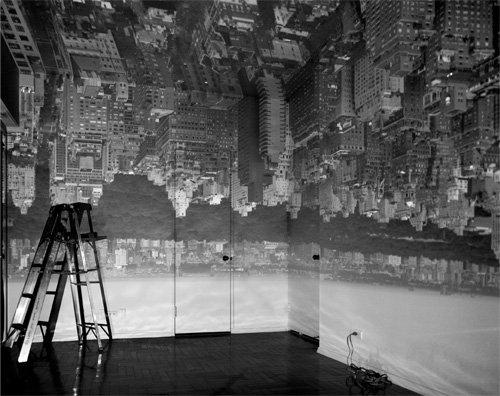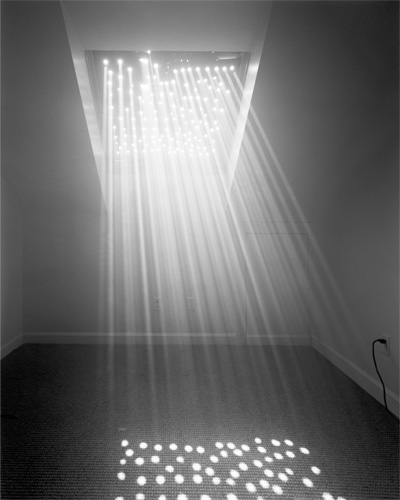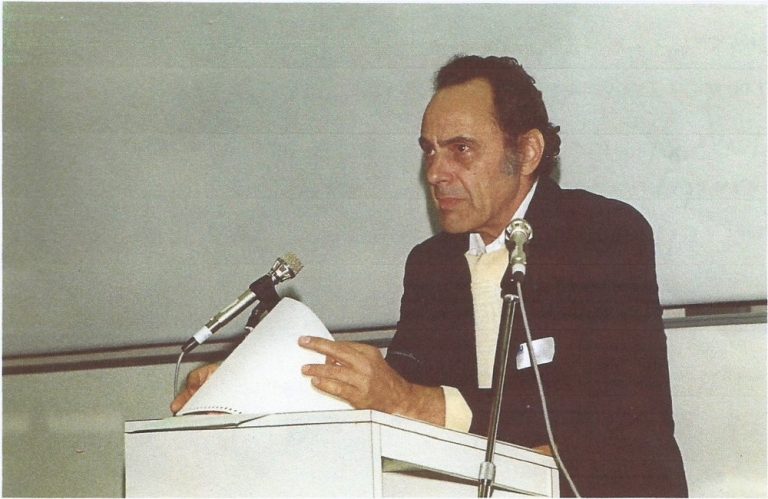For most of us, don’t-know is a place of get-me-out-of-here-quick. As a writer, sitting down to a blank page makes me instantly want to wash dishes, dust under beds, or finally sew those buttons on a coat I haven’t worn in years. But Eugene Gendlin doesn’t see don’t-know as the Bermuda Triangle of the psyche; to him it is just unexplored frontier, seas as yet uncharted—but friendly—that we can learn to navigate. For years, Gendlin offered a class at the University of Chicago in which he taught exactly that. The purpose of the class was to get students to tap into their implicit knowing—Gendlin’s term for what someone knows but is not yet able to express. “It took weeks to explain that the usual criteria were reversed in my course,” Gendlin says. Everywhere else in the university only what was clear counted at all, he explains. “Here we cared only about what was as yet unclear.” Gendlin impressed the point on his students that if what they were thinking was already clear, “We don’t need you for this; we have it in the library already.”
Founder of a popular self-actualization technique called Focusing, Gendlin has had an enthusiastic reception among North American Buddhists. Gendlin’s Buddhist students find Focusing to be compatible with meditation and use it to complement traditional contemplative practices. (For instructions on Focusing, click here). Perhaps a clue to Gendlin’s appeal among many Western Buddhists is hinted at in one of his own favorite terms: resonance. Gendlin’s approach grows out of the Western philosophical tradition (especially phenomenology) in which he is firmly rooted, yet it emphasizes transformative practice based on working with awareness in the present moment. Its relationship to Buddhist practice is close but not too close, different but not too different. Gendlin offers not a bridge between Buddhism and Western tradition but an experiential space in which the two can act upon one another—resonate—and in so doing allow something new and unforeseeable and grounded in both to emerge.

As a doctoral student in philosophy at the University of Chicago in the late 1950s, Gendlin was grappling with the relationship between symbols and lived experience. Curious about whether the process of psychotherapy might shed light on the matter, he got accepted in a therapy practicum taught by Carl Rogers, now legendary as a founder of humanistic psychology and the originator of client-centered therapy. The two began a research collaboration that would continue for eleven years.
Examination of hundreds of hours of recorded therapy sessions showed that certain clients were doomed to fail and that you could pick out those clients from the get-go. Listening to these recordings, Gendlin observed that when a therapy client turned inward in a particular way, he or she moved forward; clients who didn’t do this turning inward remained stuck. “The wisdom of the time said to separate those people who were good prospects for therapy from those who weren’t and just take those who could succeed,” he recalls, “but we couldn’t stand that.” Gendlin began to look for a method to teach the stuck clients how to get unstuck. These instructions for how to “find your inner contact” later became the technique of Focusing. Therapy clients learned to get in touch with an at first vague, bodily-felt meaning (what Gendlin calls a felt sense) and to draw that experience into articulation.
But Focusing has significance far beyond the therapist’s office. Focusing practitioners say that Gendlin’s instructions are equally the key to tapping creative waters, to bringing any kind of as yet unclear inner experience into expression. Artists, writers, and scientists all report positive results. But what caught my attention was this: some say that by honing in on precisely that inner act that separates psychological movement from stasis, Gendlin has hit on the quintessence of self-transformation. No wonder Buddhists are interested.
Gendlin is a thinker steeped in the Western tradition concerned with working past many of the dichotomies that characterize a long-standing impasse of modern thought. His Philosophy of the Implicit pulls the ground out from under classic dualities such as body/mind, material/mental, and individual/ environment. Cartesian dualism is upside down, Gendlin says. He wants to turn it right side up. In what Gendlin terms “the old view,” subjective experience is a freak of nature in a fundamentally objective, mechanistic, and dead world. In the “new view,” the living process itself is fundamental, and you and I and the world are embodied aspects of that activity. “Living is always a fresh process, forming itself freshly now,” he says.
According to Gendlin, we know a lot more than we think we do. Everything we’ve ever thought, said, or done is within us right now in an implicit complexity that both frames our possible choices and actions and is itself changed by them. In Gendlinspeak: “Whatever occurs happens into an implying and carries living forward.” This complexity is bodily and can be felt. Through Focusing, we can learn to tap this vast storehouse of bodily knowledge, and to think, speak, and act—more wisely—from this wider field.
From 1963 until 1995, Gendlin taught at the University of Chicago. Though now professor emeritus, he’s still thinking and writing—just don’t call him before noon. He has been honored four times by the American Psychological Association for his founding contributions to the field of experiential psychology, but he reports, “I never left philosophy. I want to make that clear.” He currently heads the Focusing Institute, founded in 1986 to promote felt-meaning literacy worldwide.
When Tricycle invited me to interview Gendlin, I blithely went about making my usual preparations for meeting a professor. I bought Gendlin’s book, read his papers, and prepared a five-page bulleted list of questions. In retrospect, I might have known better. That story about the Chicago class should have tipped me off. But I was a right-angle thinker about to run straight into curves.
During my three-hour conversation with Gendlin, I pitched him what I thought were straightforward questions. Again and again, his replies left me mystified. We seemed to be communicating, but I couldn’t figure out what he was saying: his words were in English, but at times it seemed he was speaking another language. Trying to nail down Gendlin’s ideas turned out to be like sitting by a goldfish pond and willing the fish to stay at the top. I would toss him a question and our conversation momentarily surfaced in shared understanding. But before I could pin him down, get him to define his terms, or resolve a lingering doubt, Gendlin dropped out of view. There would be a meaningful flurry of fins below the surface, and up he would pop—over there—with another idea that made perfect sense, for a moment. But as soon as I would try to follow him to that place, down he would go again.
Then we would pause, and he would check in to see how much I had understood. I hedged my replies, embarrassed to admit—not much! Desperately hoping for more success with a different topic, I quickly pitched a new question, and off we went again.
Eventually I got the rhythm of this dance. In the course of follow-up interviews, I learned to listen to Gendlin with my eyes closed, not just with my ears but with my whole being. And oddly, he began to make more sense that way. Eventually it dawned on me that of course he was speaking from the place he was describing and in the language he calls “fresh.” He was demonstrating Focusing through our conversation. When I started Focusing too, we began to meet.

But as a journalist on assignment, I was up against a wall. How was I going to bring readers along on the ride? I wrestled with editing those transcripts. I tried extracting just the surface snippets of our talk and stitching them together to force a logical flow: lifeless. I tried including Gendlin’s fresh phrases but restating them in ordinary English: inauthentic. I tried leaving Gendlin- speak unedited: baffling. Day after day when I sat down to write, I suddenly found myself washing dishes, doing laundry, or weeding the yard. Finally I admitted it to myself: I was flat-out stuck.
The irony wasn’t lost on me. Here I was trying to report on a method for overcoming stuck-ness while bogged down and immobilized in my own creative quicksand. Finally I began to suspect my problem wasn’t personal, that it pointed to an important fact about language. I asked Gendlin. He understood my predicament right away. Ordinary language, he explained, is steeped in the old Cartesian dualism. Because Gendlin’s ideas express a new ontology, they require new language.
I finally caved; the struggle to write this article was going to have to be part of the article. There was simply no way to avoid bringing my own process into the story.
And that, after all, was the point.
–Linda Heuman
When I first learned Focusing, I made sense of it by relating it to my Buddhist practice. But then I read articles on your website by other Buddhists. They too interpreted Focusing in terms of whatever Buddhist tradition they practiced. But the interpretations were all different. Is this a problem? It is natural to say this new thing is that old thing. People make sense of what they learn in terms of what they already know. You cannot immediately tell people what Focusing is. You don’t immediately explain to people what meditation is either. You tell them what it does for them, but you don’t tell them what it is. If you use ordinary language to say what meditation is, they will say, “Oh yeah, I do that all the time. That’s what I do when I take a break.” [Laughs]
Back in the late 1950s, when you were studying recordings of clients in therapy, what exactly did you see successful clients doing that the unsuccessful ones weren’t doing? They speak from and about their inside experiencing. They often pause, then use phrases like, “No, not quite what I said. More like…uh….” They check inside.

The therapist would say back what the client tried to say. Then the client would correct, “No, I meant it more like that…” Then the therapist would accept the correction and say back, “Oh, I see, more like that….” Therapists speak from feeling what the client wants to convey. They repeat only a few main words. The client would say, “Yes, but another thing is this and this about it.” The therapist would say, “Oh, there’s this and this about it.” Then maybe they would say once more, “Well, there’s still this.” The therapist would say this back. And then the client would exhale and say, “Ah.” [Sighs]
At this point there is always this characteristic little silence there, because they’ve finished saying what they wanted to say and they got heard, more deeply than ever. That makes one feel more connected inside. For the moment they don’t know what they’re going to say next. The people who do come from inside naturally go deeper at that point, but we needed to teach this also to the others.
How did you realize that connecting inside was a skill that could be taught? I didn’t realize it. I insisted it had to be teachable! But I didn’t know if it was. We put Focusing instructions together, and then we tested. It took a lot of nerve, because it was counter to the understanding at that time that therapy was an art, and that being a patient in therapy was an art, and that you can’t tell anybody how to do it. So it wasn’t just that I didn’t know whether it was teachable; it was absolutely the religion that it was not teachable.
The key to connecting inside through the practice of Focusing seems to be locating an inner experience you call a felt sense. You describe the felt sense in various ways: the body’s sense of a particular problem or situation; a bodysense of meaning; an internal aura that encompasses everything you feel and know about the given subject at a given time; a big, round, unclear feeling. How is a felt sense different from an emotion? Emotions are already cut up and packaged. They’re part of the story. The felt sense is not part of the story. It makes its own story, you could say; or it is a beginning of what could be a new story.
How did you discover the felt sense? I brought it from my philosophy. (Then I called it “preconceptual feeling.”) When I came to these therapists, I was learning everything from them about therapy. But I kept telling them about the preconceptual feeling, and they didn’t understand it whatsoever. They were talking about emotions and feelings. They still are! When we looked at what you actually did as a therapist when you were listening, you were not just responding to the emotion. You were responding to this whole ball of wool that the client is telling you. I wanted the client to sit with that—“I don’t know what to do, but I’ve got this…uh.”
Is the felt sense unconscious? No. You aren’t going to be able to say any of this in the old language. Everything in the old language is divided into conscious and unconscious—and this isn’t like that. Everything is divided into the same or different—and this isn’t like that. Everything is divided into thinking and feeling—and this isn’t like that. You have to make new phrase
So it’s a new kind of body experience we have all the time, but we don’t notice it because we don’t have a grid for it? It isn’t already there, but you can let a felt sense “come” any time. The felt sense is a little further down. If we refer to that place, then it comes and develops.
How would you teach beginners to find the felt sense? Suppose you are stuck. You make a spot from the stuck—a place. You say to yourself, “This spot here has me stuck; there seems to be no way out here.” After a while you learn it will have a way out; it just seems in the ordinary thinking to have no way out. Once you make a felt sense of it—that takes a little time— it will generate new points, new possibilities, and new distinctions.
You have to say: “This is a spot. It is going to be a felt sense in a minute. What quality does the body feel of it have?—Jumpy? Or heavy? Or no word for it, maybe, just that quality.” That is not just your anxiety; it isn’t the feeling. It is the whole of it that comes—all that—the underneath too. You have to have that whole thing. Then your body shifts. Then you are truly detached.

So at that point you are not the spot; you are the observer of the spot? But you have to have the having of the spot, just observing is not enough.
The way most people I’ve spoken with practice mindfulness is that they sit upstairs and everything comes up the stairs and they say, Oh, he’s angry, Oh, he is this, and Oh, he is that. They just sit upstairs and look at it all. I say, No! Go downstairs! But of course, not back into the feelings, rather the body feel of the whole thing. Then you have a felt sense, and that is how you can truly detach. Just being frozen upstairs is a kind of strong discipline, but it doesn’t give you the body easing, the body shift. If you are just the observer, you don’t change.
I have a hard time finding the felt sense. It is not easy for many people.
Do you have any advice for how to… [Gendlin suddenly contorts. For a few seconds, he flails his arms. Then he leans back in his chair.] What did I do to you?
You stopped my mind. I did at least that, but go to your body and tell me. [Silence]
I’m having an adrenaline rush because I thought something happened to you. Keep going.
I was worried… Is that a felt sense? So now you know nothing happened to me. Stay a minute and see what comes.
Uh-huh… [Outstretched hand shaking] It felt like that. And what is that? And you don’t know yet, right?
It’s hard to define. It disappears. It is there for a second, and then it just drops away. Say to yourself, knowing it’s probably not true, “That is perfectly all right with me that he did that.” [Silence]
Feels like…[hand shaking] Exactly. It brings it right back! If you attend in your body and if you say everything is fine, right away the felt sense [of not so fine] comes. So one way to let the felt sense come is to say, “Oh, isn’t that wonderful—really not angry—(or whatever)…” This could be useful when you’ve been working with a particular felt sense of a problem, and it just went away but you didn’t have a sense of resolution.
I have to apologize always when I do this surprise thing. It’s not pleasant to have that experience. But it is a very quick way to get a body sense, because there’s no way the body is not going to respond to that.
I got this sort of scared feeling, like a nervous feeling in the body. But if I sit with that now…. It doesn’t turn into anything. It doesn’t go anywhere. No, that doesn’t. But if we say, “Except for that, you’re fine,” I’m not so sure.
Not so sure. [Laughs] Now you’re Focusing and you don’t have to be good at it right away, but you’re not far from it either.
When you talk about “the body,” you seem to use that word in a whole new way. “The body is not just some kind of structure,” you have written, “the body is also the body from the inside.” Elsewhere you say, “Consciousness is bodily.” What is wrong with our ordinary view of body? The body that we have is aliving body. Mostly we were taught that the body is what we leave here when we die. I think that is a terrible mistake. The body that we have is not a dead body. We don’t know exactly how dead bodies come to be, but it is absolutely clear that this body is the living body. So we need to draw the basic concepts about “the body” from the living process.
What most people today think of as the body comes from science, and that conception changes through time. In Kant and Hegel’s time, it was mechanical. When I was younger, it was chemistry. Now it’s neurology. By the time my grandchildren grow up, it’ll be some other thing. Human beings are capable of thinking analytically. They can create a grid with abstract variables. And then if you map observations and experiences on that grid, you can take them apart and get patterns for different things and move these patterns around. You learn a great deal. If it weren’t for that, we wouldn’t have any technology. Seven billion of us couldn’t all live on this planet without that capability. So there’s no denigrating science. But you have to know that a living process is a wider story than that. Those analytic, cognitive units are not alive, and they can’t literally be read back into living.
What is the body in your view? The living body has many different meanings. The body builds itself from the embryo on. The structure is not like a machine in the sense that first you build a machine, then you turn it on. It’s turned on from the first cell, and it develops itself, and that developing never stops.
The body includes behavior possibilities. It has the sense of space in which you can do things, not just move around. The possibilities of “what we can do from here” is the space that we really live in; we don’t live in empty, abstract, geometric space.
And then on top of that, you have your thinking capacity. The thinking that you are doing varies your behavior possibilities. You might think of something and then see that you can do such and such, which you hadn’t seen before. So the thinking changes the behavior possibilities, and that in turn is reconstituting your body in various ways.
Your body takes everything you learn with you. But your body understanding is more than what you learned. It absorbs what you learn, and then it still implies further. A body isn’t only an is; it is an is and implies further.
I was just thinking how remarkable it is that the body heals itself. Is that what you are tapping into when you talk about embodied insight—this natural intelligence? No, you’re using “body” in the old meaning—that’s why it seems “remarkable” that it can heal or think. I’m talking about an inherent way that the body can think; or at least, that when we think, the body is part of that. I’m talking about the inherent way that the body has language; when we talk, the body is part of that—it’s not just the muscles or the vocal chords. It’s clear that the body is linguistic and logical. It senses clarity and also senses itself.
Is your model of the body also a shifting of viewpoint? You talk from a perspective of first-person lived experience, from the inside, rather than describing lived experience from the outside, as an objective observer would? It’s not “rather than.” I would say “in addition to.” I learn everything that I can learn from objective science, and I understand and incorporate that. Then I come back to the corpus that incorporates it. And that corpus is the body, of course.
I love every kind of research—mechanical, chemical, neurological, whatever. But you always have to take the understanding it gives you and then refer to how your understanding can go wider. That goes wider isn’t just mental; it is also bodily.
For example, if you feel some excitement or some opposition or some discomfort, go to the quality. The first thing you get on this felt sense is just a quality, and you won’t even know what to call it. You have to say it’s “ugh,” or it’s uncomfortable, or it’s “something important is happening in here and I don’t know what, but I can feel it.” If you go there and just to that quality, it very soon opens, and you say, “Oh!” And then there is a whole field of wider. You can’t do that without a living body.
Can we trust the going-wider? Is this process always moving toward the good? Definitely. It is always trustworthy. What “trustworthy” means, though, depends here: it is your living forward, that it moves toward. It moves toward being able to breathe if you can’t breathe. It moves toward relaxing when you’re tense. It moves toward mobilizing when you’re in a funk and you can’t get moving. It moves toward more life. And yet—what that means varies.
What do you mean? Where we really speak from is always a unique implicit intricacy, and yet we can understand each person if we listen and they keep correcting our understanding.
One friend came to see me. He was about 35 or 40 years old and had a wife the same age. It turned out she was dying of cancer. When I heard that, I felt bad, of course. Then I said to him, “That’s terrible! Somebody young with young children shouldn’t die.” Well, I’ve said that to many people, but when I said it to him, it broke him up. He cried and sobbed and was so relieved. It turned out that he had this internal conviction that what happens is what God wants, so it has to be right. He was forcing himself to feel that it is right. Since he invested me with a certain amount of respect, what I said came as a huge relief that he didn’t have to feel it was right. It is actually wrong for a young person to die.
Many years later, a friend from Germany came to see me. He was also in his 40s. He told me a friend his own age had recently died. After that, he couldn’t get over his fear that he too might die soon. Then, with the Focusing, he discovered it wasn’t really death that he feared. It was that he believed that dying when you are that age is wrong. Es ist nicht erlaubt—it is not permitted! And as soon as he realized that that was what it was, it dissolved completely. It was really a deep place in him where he didn’t want to do what ist nicht erlaubt. And so he was holding his breath and trying to prevent doing this bad thing.
These principles would seem to be opposites. One person is freed by hearing it is wrong to die when you’re young; and the other one is freed by realizing it is not wrong to die when you’re young. When we listen to the implicit intricacy that the person is coming from, then both people are right and we can understand both.
So the process is good in the sense that it is toward life, toward freedom, toward openness? It’s trustworthy in the sense that you can go with it. But if you take the words literally, that doesn’t work either. The very next step, the road may turn and you may realize, “Oh, it really is this other way.”
Buddhist meditators generally take for granted that if they practice over time, meditation will change them. Has your long-term practice of Focusing had a transformative effect on you? Oh, yes. Every day I’m becoming more able to do things I wasn’t able to do but always wanted to; like write certain things or really listen to my wife. You never get to the end, once you’re in that process. When somebody tells me they got to the end of it, I don’t believe them. I don’t think they know this process, then.
So it’s built into the practice that it’s continual and inexhaustive? People get stuck for decades with the same problems over and over. Focusing expands you. Then you live in more ways and have new problems. Somebody once asked me what I thought mental health was. I said, “New problems!”
Can Focusing help people with oppositional worldviews to understand each other better? How? It isn’t a matter of integrating opposites! It is a matter of going to a different place. If you don’t go to this body-sense place, if you stay at the level of conceptual formulation, then you can’t integrate opposites; they round each other off and you have nothing. If you go to the felt sense, then you can look for how the opposite statement also comes from there. Then the opposite understanding doesn’t actually make an opposite. If we listen to your felt sense and you are willing to keep correcting my understanding of it, then I will discover, “Oh, in that meaning it makes sense.”
Is there some built-in limitation with language, that it has a hard time getting at this experience of felt sense? Yes, if what you mean by language is standard phrases. But language is vastly more than standard phrases. Language can come up fresh from your body sense right now; it can make new phrases and speak from there; words and sentences and phrases come. Then it sounds funny, and a lot of people won’t understand it. But they won’t misunderstand it either, because it is so clearly not the old thing. When they know they don’t understand it, they can say, “What do you mean?” And you get a chance to say more.
Thank you for subscribing to Tricycle! As a nonprofit, we depend on readers like you to keep Buddhist teachings and practices widely available.
